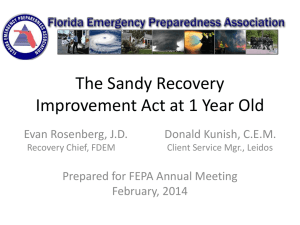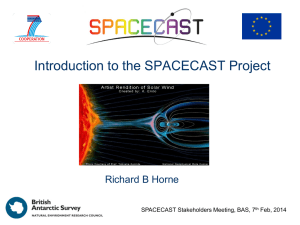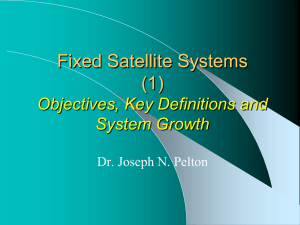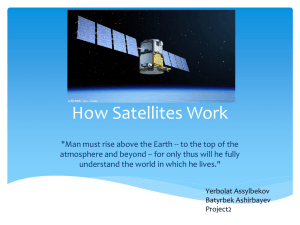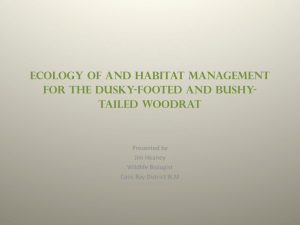IAC-10.A6.2.10 Effects of Space Debris on the Cost of
advertisement
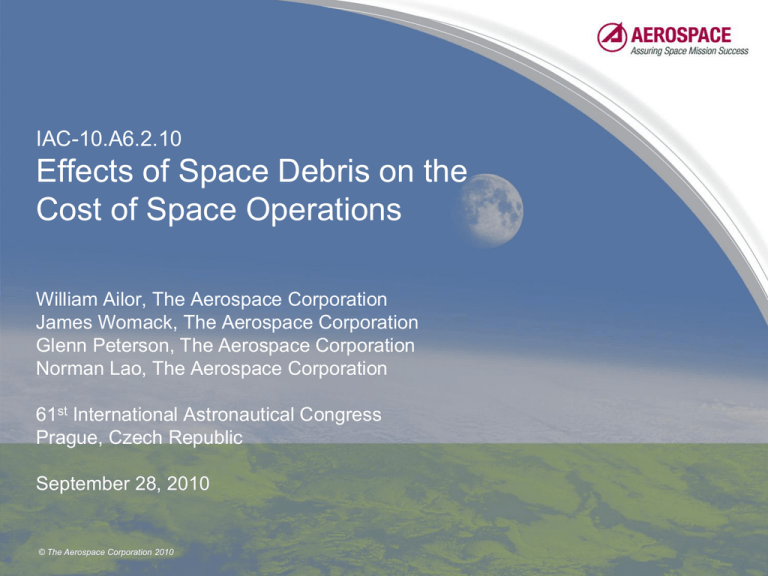
IAC-10.A6.2.10
Effects of Space Debris on the
Cost of Space Operations
William Ailor, The Aerospace Corporation
James Womack, The Aerospace Corporation
Glenn Peterson, The Aerospace Corporation
Norman Lao, The Aerospace Corporation
61st International Astronautical Congress
Prague, Czech Republic
September 28, 2010
© The Aerospace Corporation 2010
Overview
• Background
• Study Approach
• Satellite Model
• Constellations
• Debris Model
• Debris Effects on Satellite Lifetime
• Debris Effects on Cost to Maintain Constellations
2
Today
• Have about 1000 operating satellites
• More than 20,000 tracked objects
• Up to 600,000 pieces of debris large
enough to cause loss of a satellite
• Millions of smaller particles that can
degrade performance
3
Possible Futures
25000
Effective Number of Objects (>10cm, LEO)
Total
•
No mitigation (no post-mission
maneuvers to dispose of hardware)
•
•
•
200 to 2000 km altitude orbits
Intacts + mission related debris
20000
Exp fragments
Col fragments
15000
10000
Predicts ~24 collisions in next 100 years
J.-C. Liou, “A statistical analysis of the future debris
environment,” Acta Astronautica 62 (2008) 264 – 271.
5000
0
1955
1997-2004 launch cycle
1965
1975
1985
1995
2005
2015
2025
2035
2045
2055
2065
2075
2085
2095
2105
Year
LEO Environment Projection (averages of 100 LEGEND MC runs)
20000
Effective Number of Objects (>10 cm)
NASA study* shows removal of 5 large
debris objects/year will stabilize population
of orbiting objects in LEO
•
Discussions beginning on debris removal
technique
PMD + ADR02
16000
PMD + ADR05
14000
12000
10000
*J.-C. Liou and N.L. Johnson, “Active Debris Removal - The Next
Step in LEO Debris Mitigation,” 26th IADC Meeting, 14-17 April
2008, Moscow, Russia.
8000
6000
4000
2000
0
1950
1970
1990
2010
2030
2050
2070
2090
Year
4
•
PMD
18000
2110
2130
2150
2170
2190
2210
•
•
•
PMD—Post-Mission Disposal actions
ADR—Active Debris Removal
Select objects with the highest [ mass Pc ], where Pc is
the instantaneous collision probability at the beginning of
the year
Effects on Satellites and Satellite Operations
• Higher costs of constellation maintenance
– Replace degraded and destroyed satellites
– Increased costs of satellites (robustness)
• More collision avoidance maneuver actions (if service
available)
– Depends on quality of data
• Increased threat during launch
– Possible launch holds
What will be the effect on cost?
5
Analysis Approach
• Project populations of orbiting objects for 50 years
• Define three generic satellites
• Define critical areas for each satellite type and size of
impacting object
– 1 mm to 1 cm (untracked)—degrade solar panel performance
– 1 cm to 10 cm (untracked)—degrade solar panel or kill satellite if
strikes critical area
– >10 cm (tracked objects)—strike anywhere kills satellite
• Place satellites in “constellations” at worst-case altitude (850
•
•
•
6
km)
Assume constellations fully constituted in 2010, 2020, 2030
Estimate changes in satellite lifetime due to debris environment
Estimate increased cost to maintain constellation at full
strength for 20 years
Three Satellite Types & Sizes
• Government satellite
X direction
Y
direction
– Multiple missions
– High reliability
– High cost
• Commercial #1
Z direction
Generic Government Satellite
– Medium cost
• Commercial #2
X direction
Z direction
Generic Commercial Satellite
7
Y direction
– Single mission
– Low cost “factory built”
Debris Damage Assumptions
Satellite Type
Government
Minimum Exposed
Area (m2)
5.5
Maximum Exposed
Area (m2)
15.5
Commercial #1
Commercial #2
8
6.5
24
22.5
solar arrays
•Impacts on bus and payload
{not fatal}
0
{fatal only in
critical areas}
1 cm
{fatal anywhere on bus and payload}
10 cm
Size of debris
•Impacts on solar arrays
50% chance of no damage
40% chance knocks out 1 string
5% chance knocks out 2 strings
5% chance of fatal impact*
No Damage
0
1 mm
1 cm
critical areas
50% chance knocks out 2 strings
35% chance knocks out 3 strings
10% chance knocks out 4 strings
5% chance of fatal impact*
10 cm
*This accounts for impact to harness, root connector, or yoke which would remove 25-100% of the array power and causes loss of mission
8
Constellations
Government
Constellation
9
Commercial #1
No. of Satellites in Satellite Design Satellite Unit Cost
Constellation
Life (Years)
($M)
Commercial #2
Launch
Cost ($M)
Notes
Government
5
6
750
250
Heavy lift ELV
Commercial #1
20
9
250
80
Medium lift ELV
Commercial #2
70
12
50
80
Medium lift ELV, 5 satellites
co-manifested per launch
Location of Constellations
• Satellites placed in region
where flux of objects (and
probability of collision) is
highest
• Sun-synchronous orbits at
850 km
Location of constellations
10
Debris Size Ranges & Flux
• Debris flux estimated using
Aerospace model (>10 cm objects)
and modified version of ESA’s
MASTER05 (1 cm & 1 mm
particles)
– Includes man-made debris,
micrometeoroids, operating satellites
– Historical population up to 2005
– Model for 2010 and beyond adjusted
for 2007 Chinese ASAT and 2009
Iridium/Cosmos debris
– Added 2 to 3 debris producing events
each decade
– Collisions create debris clouds similar
to Iridium-Cosmos collision
• All satellites in highly inclined, sun
synchronous orbits at ~850 km
11
Satellite Reliability Results
Satellite Type
Mean
Lifetime
(No
Debris)
Launch Year
Mean Lifetime &
Percent Reduction
(With Fatal Impacts Only)
Mean Lifetime &
Percent Reduction
(All Impacts)
2010
2040
2010
2040
Government
5.67
years
5.55 years
2.1%
5.54 years
2.3%
5.48 years
3.4%
5.42 years
4.4%
Commercial #1
8.97
years
8.56 years
4.6%
8.52 years
5.0%
8.29 years
7.6
8.17 years
8.9%
Commercial #2
12.26
years
11.63 years
5.1%
11.56 years
5.7%
11.24 years
8.3%
10.65years
13.1%
2-6% decrease
12
3-13% decrease
Constellation Replenishment Results
13
Constellation
Year
Constellation
Constituted
Number of
Replenishment
Launches
(No Debris)
Number of
Replenishment
Launches
(With Fatal Impacts
Only)
Number of
Replenishment
Launches
(All Impacts)
Government
2010
2020
2030
20.1
20.1
20.1
20.4 (2% Increase)
20.5 (2% Increase)
20.5 (2% Increase)
20.8 (4% Increase)
20.8 (4% Increase)
20.9 (4% Increase)
Commercial #1
2010
2020
2030
51.4
51.4
51.4
53.7 (5% Increase)
53.8 (5% Increase)
54.1 (5% Increase)
55.9 (9% Increase)
55.9 (9% Increase)
56.2 (9% Increase)
Commercial #2
(5 sats/launch)
2010
2020
2030
24.1
24.1
24.1
25.9 (7% Increase)
25.9 (7% Increase)
26.0 (8% Increase)
27.5 (14% Increase)
28.0 (16% Increase)
28.5 (18% Increase)
2-8% increase
4-18% increase
Replenishment Costs due to Debris
Cost Assumptions
Results
Constellation
14
Constellation
Satellite Unit
Cost ($M)
Launch Cost
($M)
Notes
Government
750
250
Heavy lift ELV
Commercial #1
250
80
Medium lift ELV
Commercial #2
50
80
Medium lift ELV, 5 satellites comanifested per launch
Replenishment Cost ($B)
Year Constellation
Constituted
No debris
Fatal only
All impacts
Government
2010
2020
2030
20.1
20.1
20.1
20.4 (1% increase)
20.5 (2% increase)
20.5 (2% increase)
20.8 (3% increase)
20.8 (3% increase)
20.9 (3% increase)
Commercial #1
2010
2020
2030
17.0
17.0
17.0
17.7 (5% increase)
17.8 (5% increase)
17.9 (5% increase)
18.4 (9% increase)
18.4 (9% increase)
18.5 (9% increase)
Commercial #2
2010
2020
2030
7.9
7.9
7.9
8.5 (8% increase)
8.5 (8% increase)
8.6 (9% increase)
9.1 (14% increase)
9.2 (16% increase)
9.4 (18% increase)
1-9% increase
3-18% increase
Summary
• Results indicate slow cost increase due to debris
environment at worst-case altitude
• Small cost increase to operate in debris environment for
next 30 to 50 years
• Higher increase for commercial satellites due to lower solar
panel margins; Increasing solar panel robustness reduces
cost increase by ~50%
• Collision avoidance service reduces cost increase by ~10%
15




